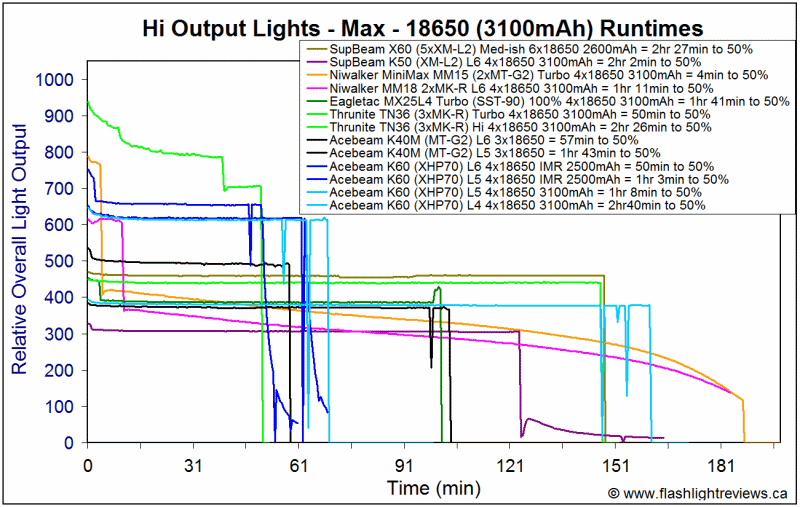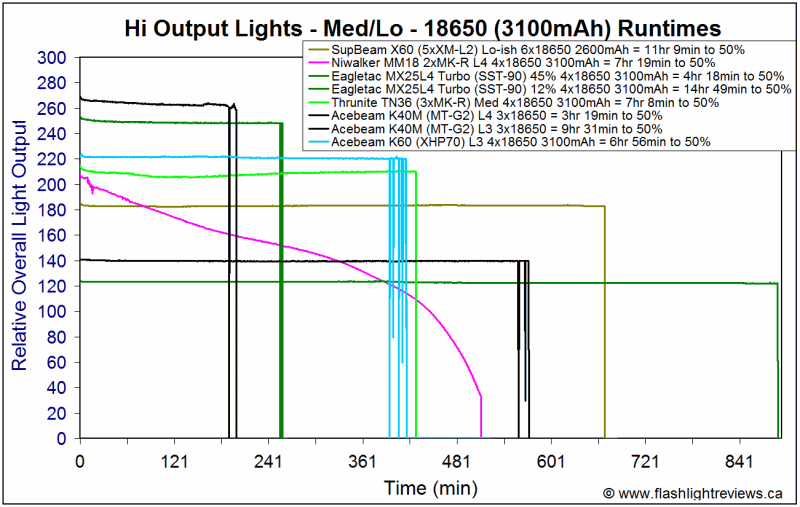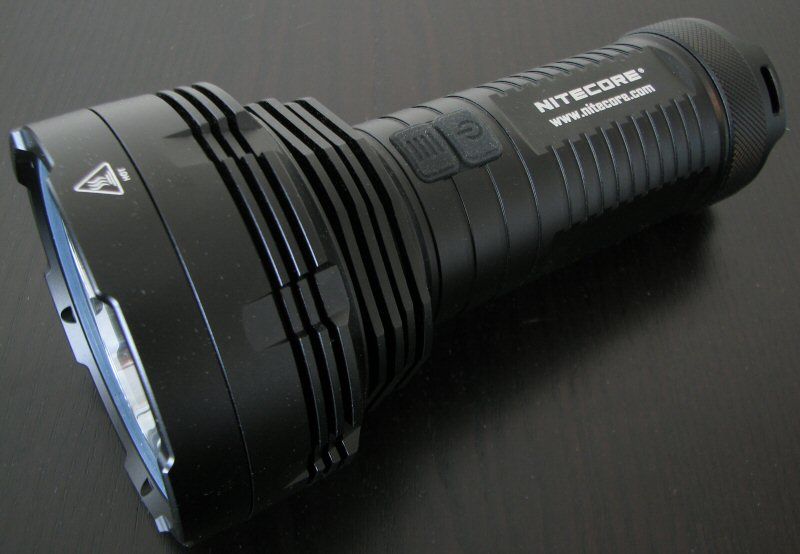

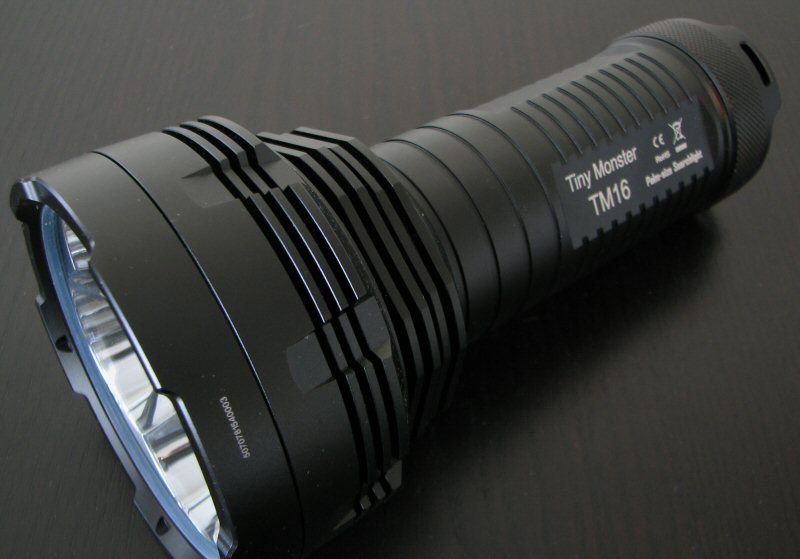
The TM16 is a latest member of the "Tiny Monster" series from Nitecore – although this one seems to be moving away from the "Tiny" monicker.
Let's see how it compares to other recent lights in this class that I've reviewed recently.
Manufacturer Reported Specifications:
Note: as usual, this is just what the manufacturer provides. Scroll down to see my actual testing results.
- LED: 4x CREE XM-L2 (U2)
- Battery: 4 x 18650 batteries (Batteries NOT included)
- Output mode/Runtime: Turbo: 4000 lumens (45 minutes), High: 1780 lumens (2 hours, 30 minutes), Mid: 680 lumens (6 hours), Low: 280 lumens (16 hours, 30 minutes), Ultra low: 5 lumens (520 hours)
- Specifications determined using 2600mAH 18650 battery
- Max Beam Distance: 700 meters
- Peak Beam Intensity: 122,500cd
- Advanced Temperature Regulation (ATR) technology
- Dual-switch user interface ensures one-handed easy operation
- Features 5 brightness levels and 3 special modes
- Integrated power indicator light displays remaining battery power
- Power indicator's secondary function displays battery voltage
- Constructed from aerograde aluminum alloy
- Sturdy HA III military grade hard-anodized
- Waterproof in accordance with IPX-8 (two meters submersible)
- Impact resistant to 1.5 meters
- Tail stand capability
- Dimensions: Length: 7.17", Bezel Diameter: 3.5", Body: 2.09"
- Weight: 17.85 oz (506g)
- MSRP: ~$200
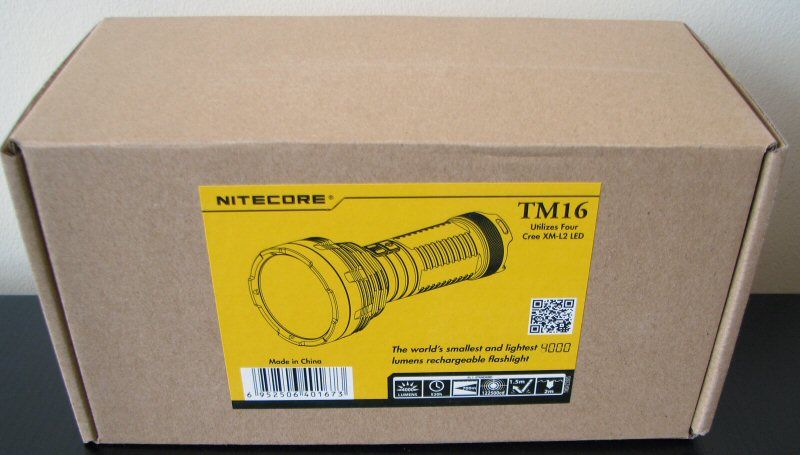
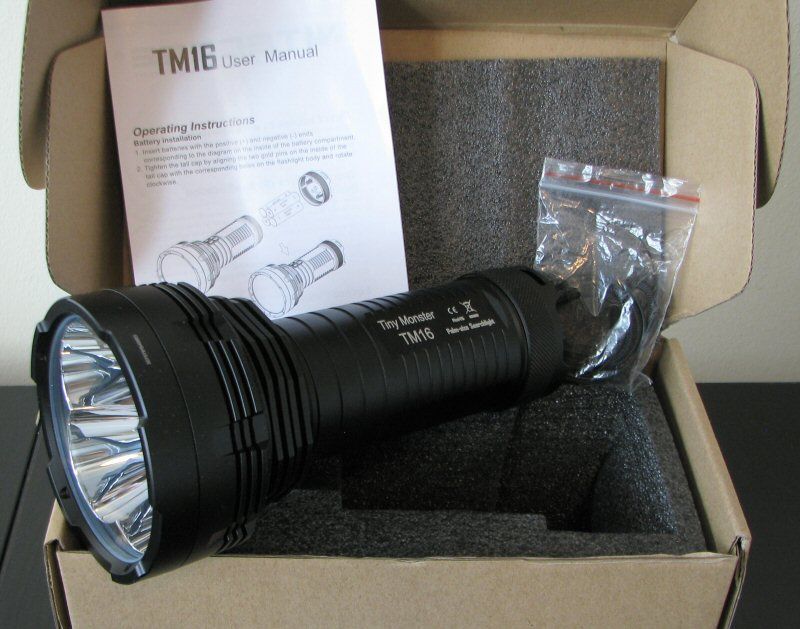
Packaging is the standard cardboard box with built-in packaging foam from Nitecore. Inside you will find the light, extra o-ring, simple wrist lanyard (with threading wire), and manual. Note that there is no holster.
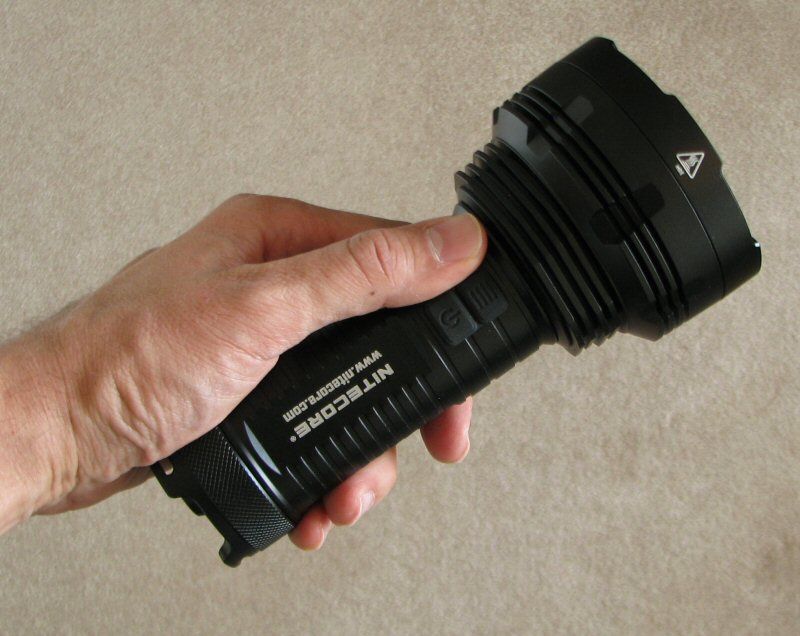
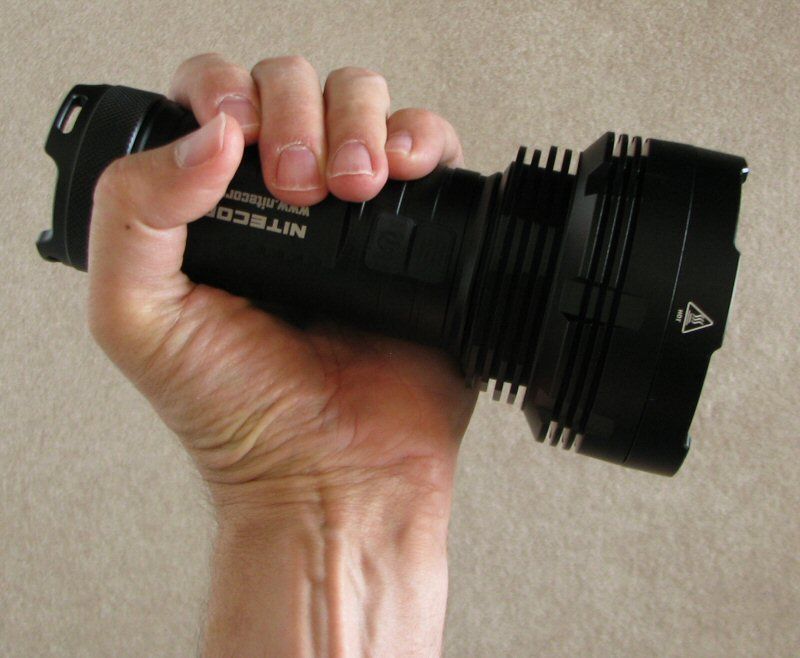
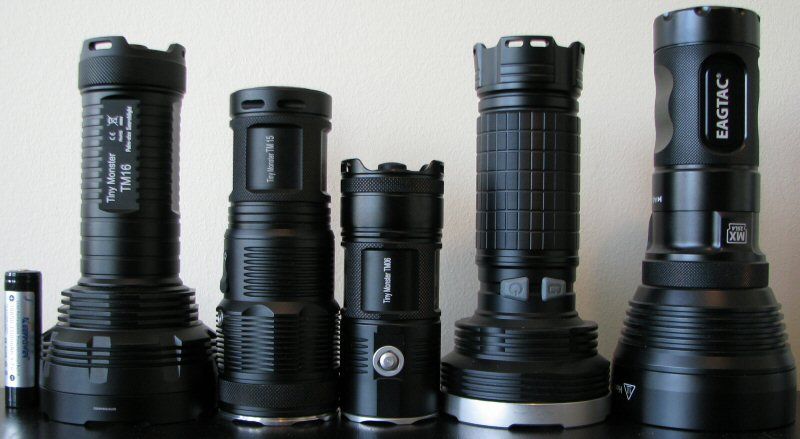
From left to right: Keeppower protected 18650 3100mAh; Nitecore TM16, TM15, TM06; Fenix TK75, Eagletac MX25L4.
All dimensions are directly measured, and given with no batteries installed:
Nitecore TM16: Weight: 508.4g (697g with 4x18650). Length 181mm, Width (bezel): 88.9mm
Nitecore TM06: Weight: 276.4g (464g with 4x18650), Length 123.9mm, Width (bezel): 50.0mm
Nitecore TM11: Weight: 342.6g (531g with 4x18650), Length 135.3mm, Width (bezel): 59.5mm
Nitecore TM15: Weight: 450.6g (639g with 4x18650). Length 158mm, Width (bezel): 59.5mm
Acebeam K60: Weight: 593.2g, Length: 207mm, Width (bezel): 88.0mm
AceBeam K40M: Weight: 498.4g, Length: 188mm, Width (bezel): 76.2mm
Eagletac MX25L3C 3x18650: Weight: 345.9g, 352.0g with kit tailcap (485-491g with 4x18650), Length: 141.9mm, 143.6mm with kit tailcap, Width (bezel): 61.9mm
Eagletac MX25L4 Turbo (SST-90): Weight: 741.0g (926g with 4x18650), Length: 203mm, Width (bezel): 92.7mm
Fenix TK75: Weight: 516.0g (700g with 4x18650), Length: 184mm, Width (bezel): 87.5mm
Lumintop SD75: Weight: 825.3g, Length: 247mm, Width (bezel): 88.4mm
Thrunite TN35 (MT-G2): Weight: 571.4g (723g with 3x18650), Length: 201mm, Width (bezel): 78.9mm
Definitely a departure for the TM-series. Think of the TM16 as a very big brother to the TM06.
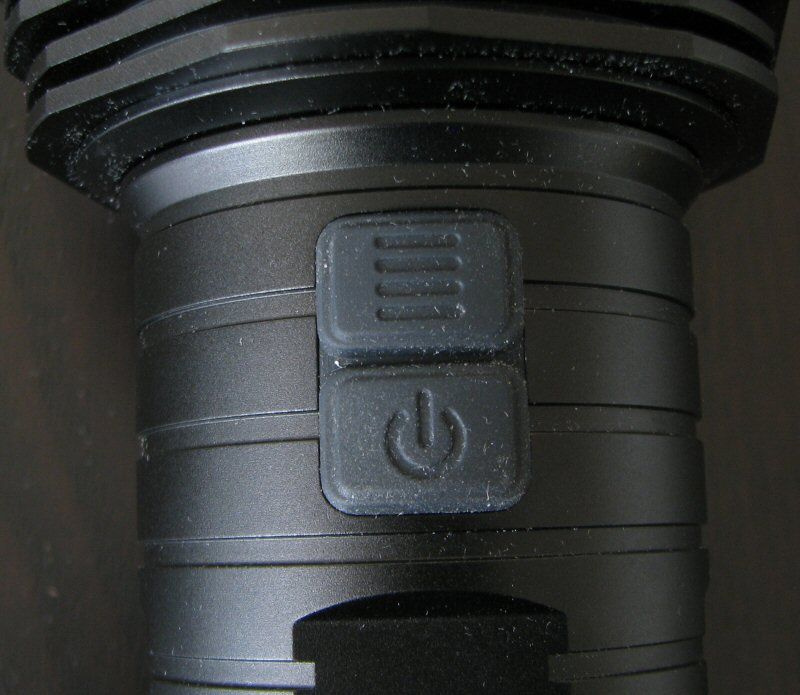
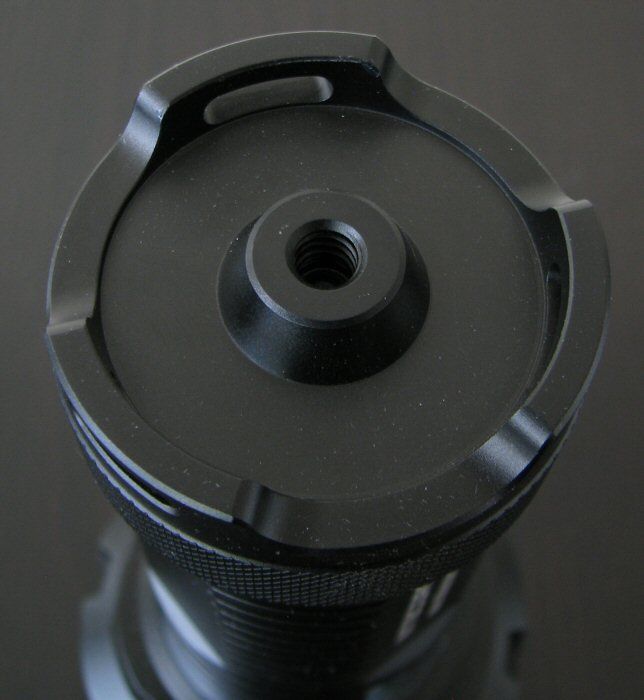
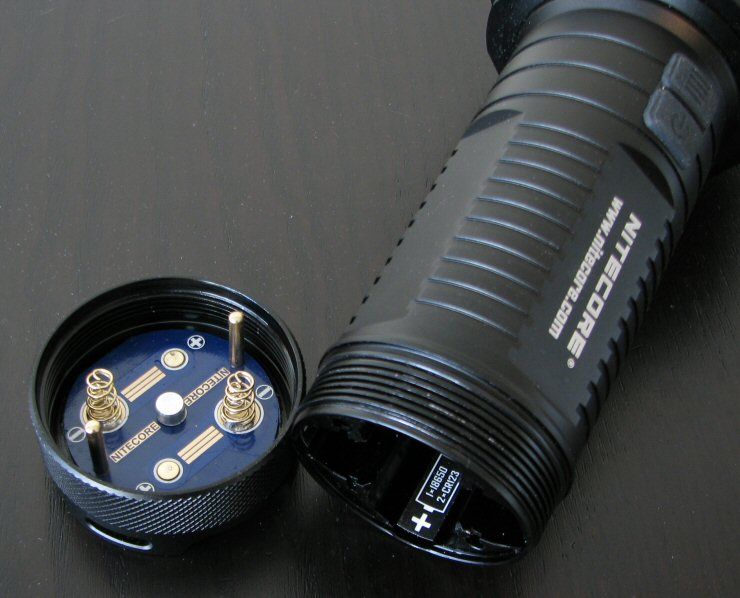
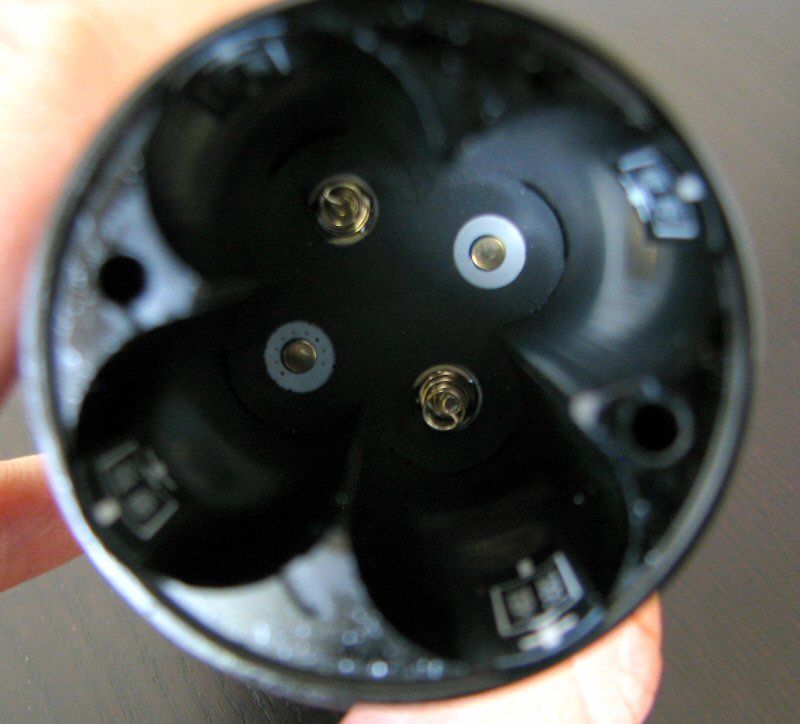
This is a much larger light than any of the earlier Tiny Monster series, due to the greatly enlarged head. The physical interface has also changed, eschewing the two-stage "camera-button" style light on the earlier TM11/TM15, in favor of a two-button option as seen on the EA41, for example. Overall feature set and functionality remains similar across the TM-series, however.
As with other TM-series lights, there are cylindrical ridges along the body to help with grip – and extra heat-sinking fins on the head of the TM16. There is no knurling per se, except on the tailcap (but is fairly mild here), but overall grip is good. Light can roll, but cut-outs in the head help limit this.
Anodizing is matte finish (flat black). Body labels are fairly extensive, but not as bad as some of the earlier models. Labels remain very legible and clear.
The TM16 uses two rubberized square buttons, located one above the other, as on the EA41. The lower button is the power button, and the upper is the mode changing button (see my User Interface section for more info). Button feel is fairly "grippy", and they are slightly raised. Like the EA41, there a single blue LED located underneath the switch area. This is used to signal the state of the light (i.e., battery status, standby). Scroll down for an explanation of the interface.
Battery handle more like the multi-cell EA-series design than the earlier TM-series, with the batteries arrange in series, not parallel. The TM16 uses a similar tailcap design to the multi-cell EA-series lights. Screw threads are square-cut and anodized, but it doesn't really matter, because the connection is carried by the contacts in the tailcap and not the body. You would need to loosen the tailcap more than half-way off to break this contact and lock out the light.
The light can tailstand. There are cut-outs on the base to allow you thread a wrist-lanyard through. There is also a tripod screw mounting area on the base (which seems like a bit of an odd location for one).
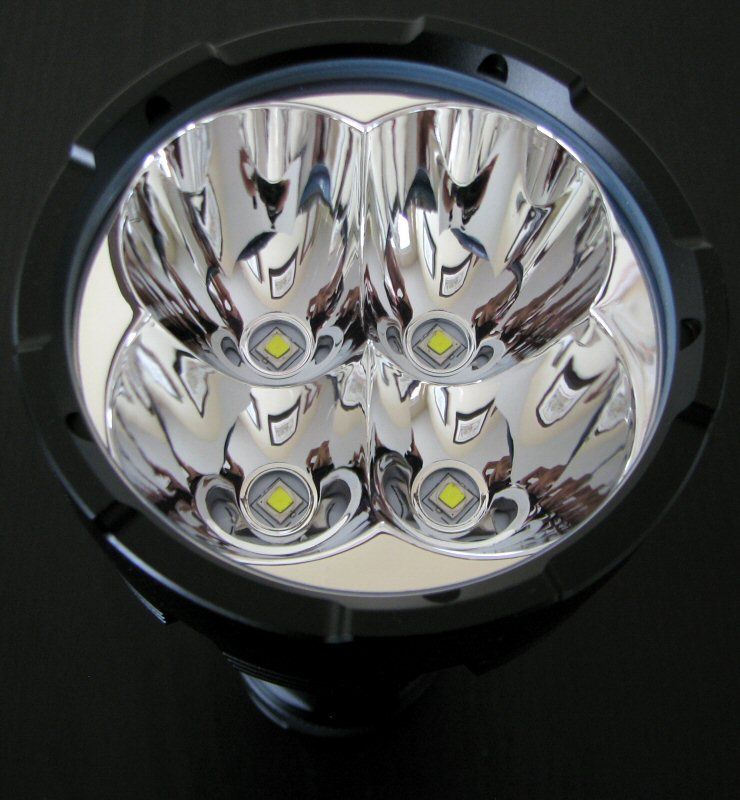
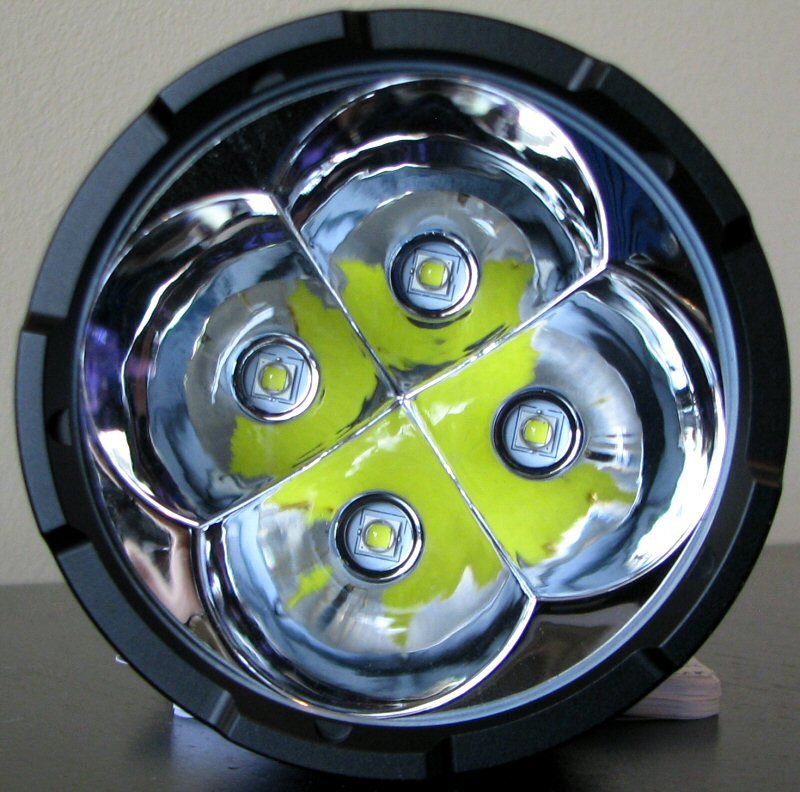
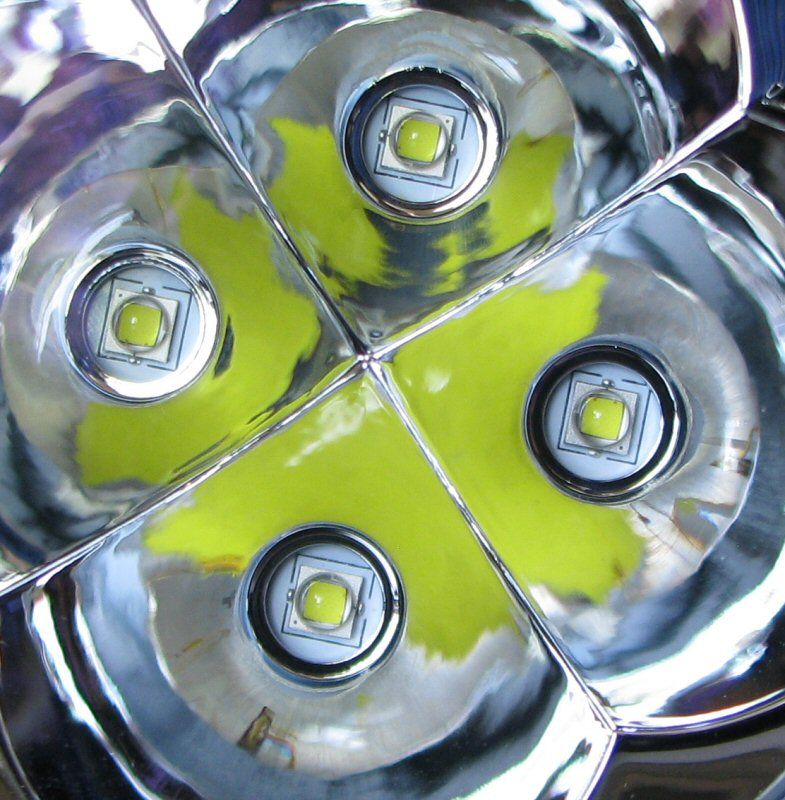
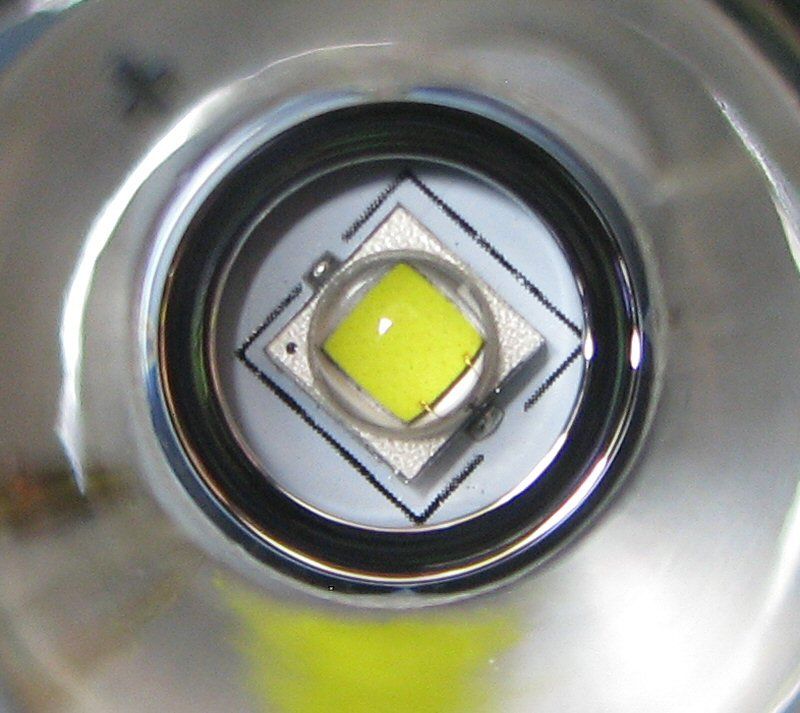
The TM16 uses 4xXM-L2, each at the base of a fairly deep smooth reflector well within the larger reflector. As with most lights of this type, there is a lot of overlap between the wells. This should translate into good throw for the size and output, but with overlapping spillbeam artifacts. Scroll down for beamshots.
User Interface
The user interface is similar to the earlier TM-series lights, but adapted to the two separate switches (i.e. multi-cell EA-series lights).
Activation is controlled by the lower power switch – press and release (i.e., click) to turn the light on at the previously memorized constant output level. Click the power switch again to turn off.
While on, click the upper mode switch repeatedly to cycle between the five main output levels in the following repeating sequence: Lower > Lo > Med > Hi > Turbo, in a repeating loop. The light has mode memory, and will return to the last level used when turned back on from off.
For the special modes (i.e., blinking modes), these are normally accessed from On. With the light on, press and hold the mode switch for more than 1 sec. The light will enter into Strobe. To advance to Location (aka beacon mode), press and hold the mode switch again. To advance to SOS, press and hold the mode switch again. A click of the mode switch exits back to constant output modes. Note that there is no memory for the blinking modes.
There are a couple of shortcuts from Off available. Press and hold the power switch from Off for more than 1 sec to activate in Lower. Press and hold the mode switch from Off for more than 1 sec for Turbo. Cycle through modes or turn off as before. You can also jump directly to strobe from Off by a double-click of the mode switch.
The light will read-out the voltage of the cells when you first connect the tailcap, by a series of blue flashes under the switch cover. The first set of flashes is number of volts (i.e., 2, 3, or 4), followed by a pause, and then 1/10ths of a volt (1 to 9).
You can also check the relative battery capacity by a single click of the Mode switch when off. The light flash up to three times, with 3 flashes means there is >50% battery life remaining, 2 flashes indicate <50%, and 1 flash means the batteries are almost dead. Odd that Nitecore included both methods, but there you are.
To activate the "special" standby feature, press and hold the power switch when turning Off the light. The faint blue locator LED will flash every ~3 secs in this standby mode. This standby flash is disabled by default when you just click Off.
To lockout the light, you need to start with the light On. Press and hold both buttons for more than 1 sec to electronically lock-out the light. The main beam will flash once to confirm the lockout. The same sequence (from Off) is required to unlock the light.
Video:
For more information on the light, please see my brief overview here:
As with all my videos, I recommend you have annotations turned on. I commonly update the commentary with additional information or clarifications before publicly releasing the video.
Strobe
There is no sign of PWM on any level – the light is current-controlled. :thumbsup:

Strobe is a fast tactical 19 Hz strobe.
Standby Drain
A standby current drain is inevitable on the TM16, due to the electronic switches in the head. Unfortunately, I'm not able to easily measure it, as the batteries are arranged in series (i.e., I would have to connect everything under tension, without the tailcap in place, to get a reading). It is usually reasonable on Nitecore lights, but their lights often drain cells in months (not years).
Note that you cannot easily break this current by unscrewing the tailcap - it needs to be unscrewed at least half-way to reliably block the current. As with many other models in this class, it is the tension on the springs that maintains the connection (i.e., it has nothing to do with the anodized threads).
The TM16 does include an electronic lock-out mode. I don't know how much this lowers the standby current, but it may. I recommend you make use of it.
Beamshots:
And now, what you have all been waiting for.
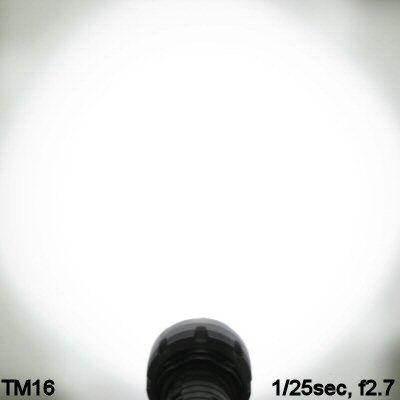
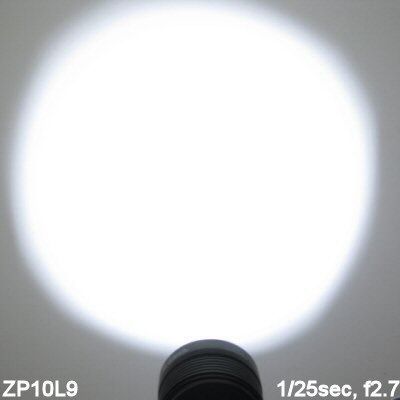
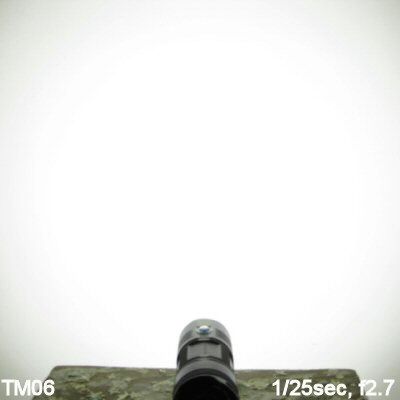
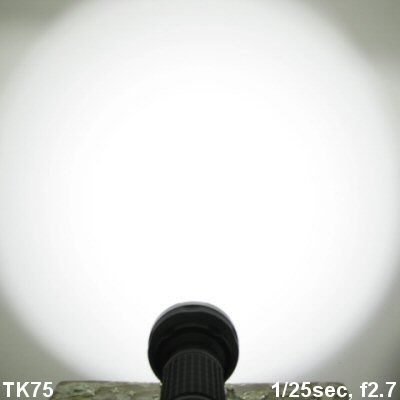
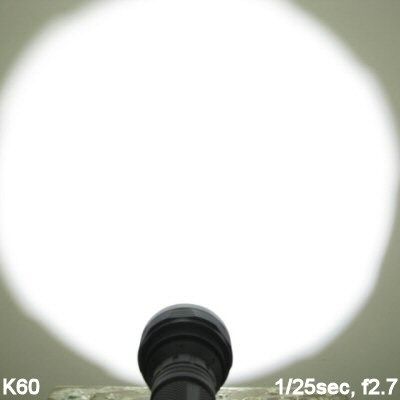
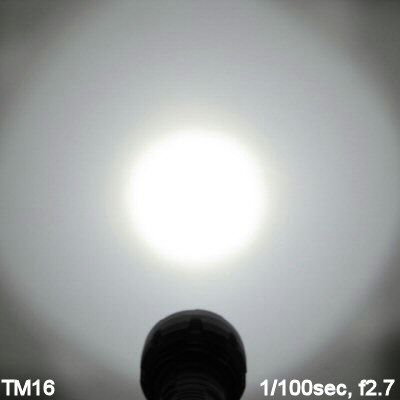
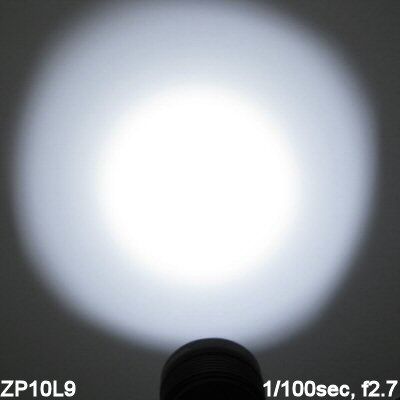
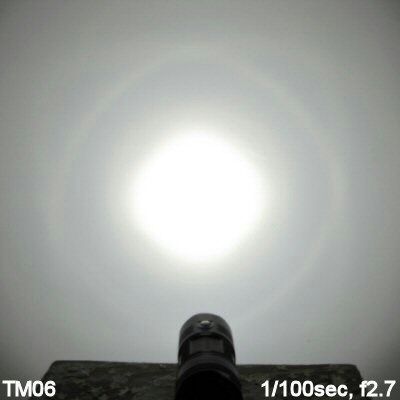
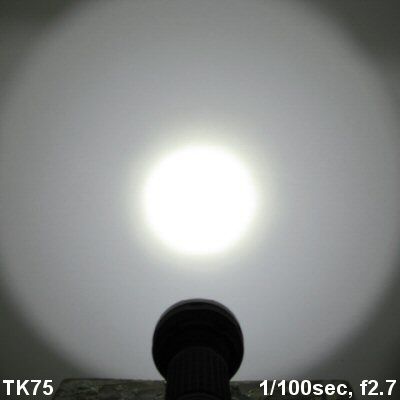
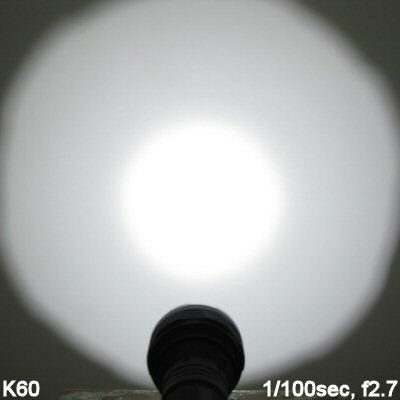
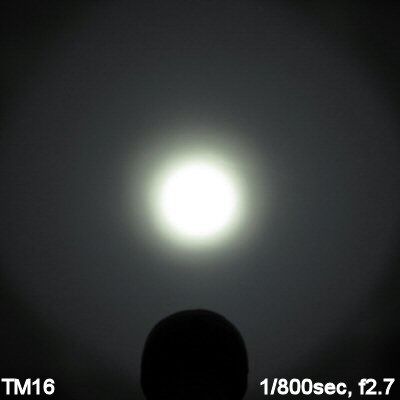

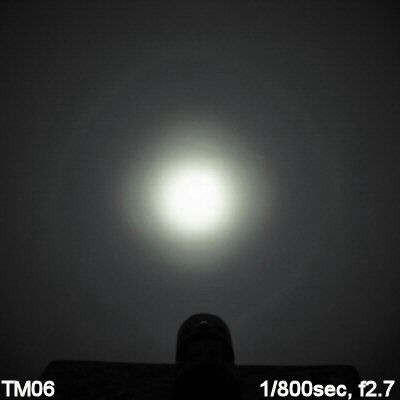
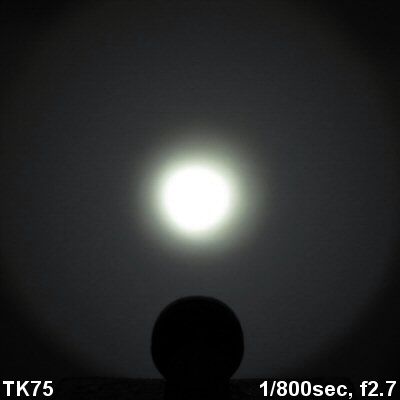
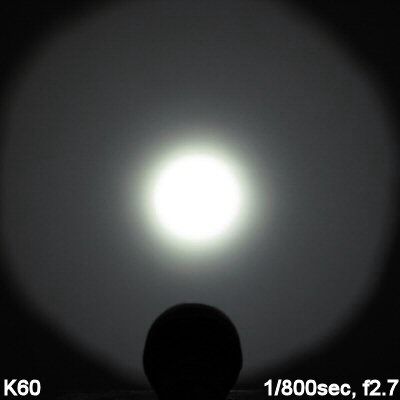
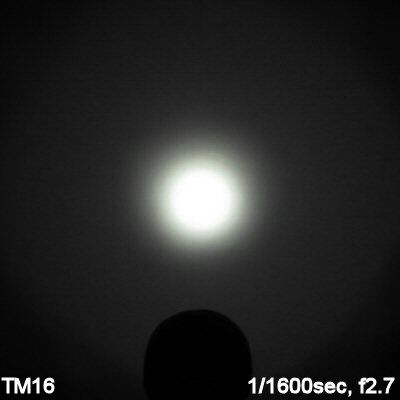
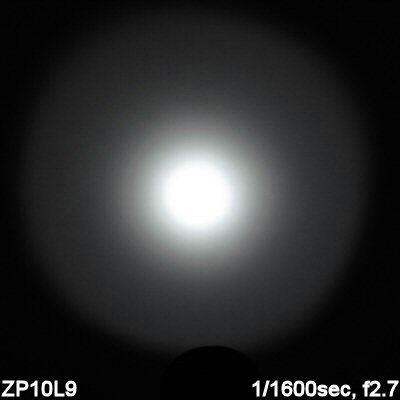
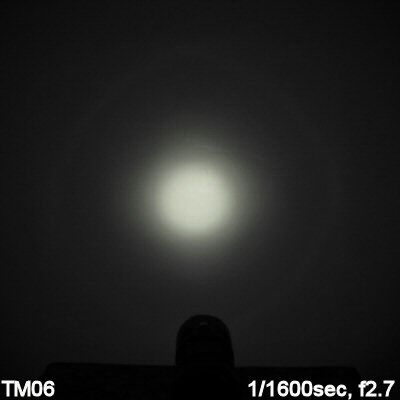
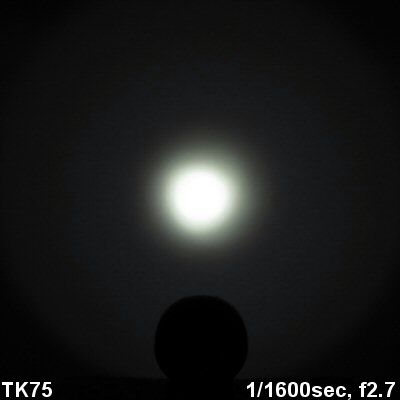
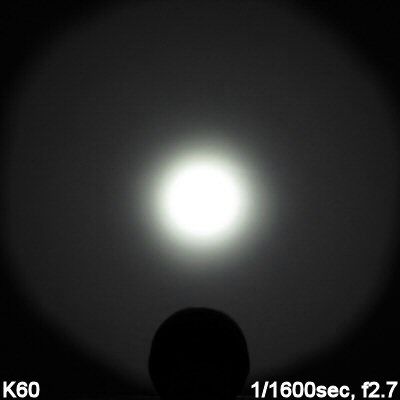
The TM16 is an excellent thrower for the multi-emitter class. It's a bit hard to see above, but the four overlapping beam wells do produce significant artifacts in the periphery of the spillbeam. You can see this a bit better here:
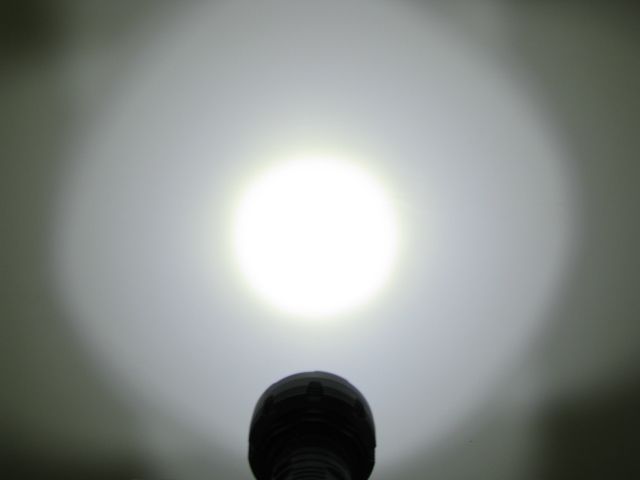
For outdoor shots, these are done in the style of my earlier 100-yard round-up review. Please see that thread for a discussion of the topography (i.e. the road dips in the distance, to better show you the corona in the mid-ground). Note there are a lot of bugs out at this time of year, so expect to see some flight trails.
Sorry about any tint effects – I accidentally left the camera on Automatic color balance for these shots. Please see my review catalog at flashlightreviews.ca for the AceBeam K40M, Eagletac ZP10L9, and Lumintop SD75 reviews.


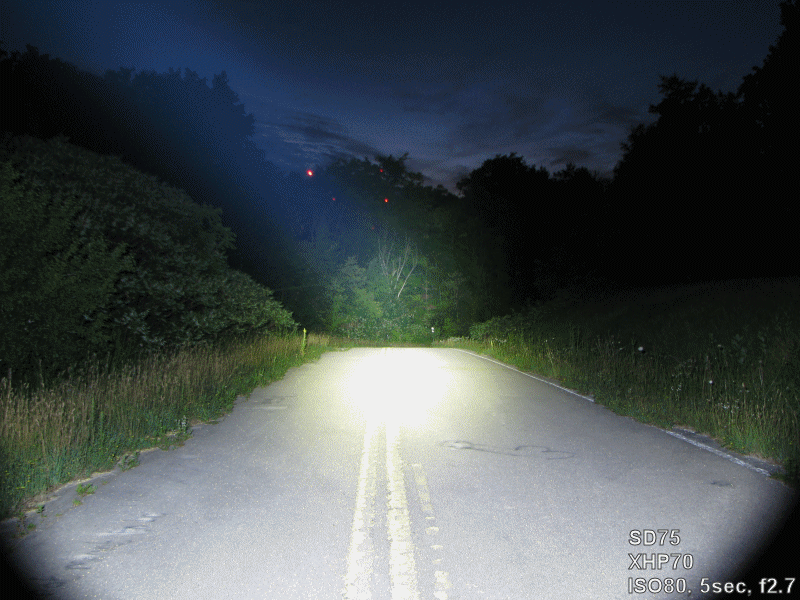

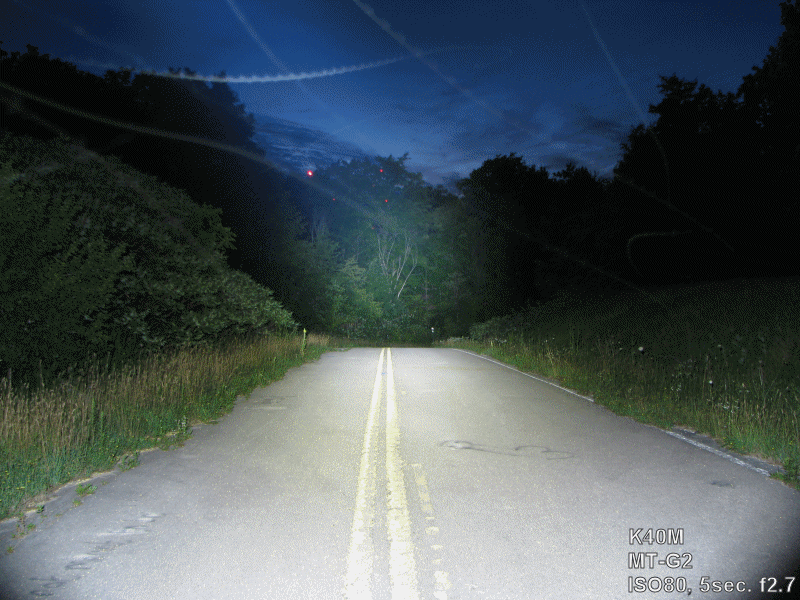

Scroll down for direct beam measurements.
Testing Method:
All my output numbers are relative for my home-made light box setup, as described on my flashlightreviews.ca website. You can directly compare all my relative output values from different reviews - i.e. an output value of "10" in one graph is the same as "10" in another. All runtimes are done under a cooling fan, except for any extended run Lo/Min modes (i.e. >12 hours) which are done without cooling.
I have devised a method for converting my lightbox relative output values (ROV) to estimated Lumens. See my How to convert Selfbuilt's Lightbox values to Lumens thread for more info.
Throw/Output Summary Chart:
My summary tables are reported in a manner consistent with the ANSI FL-1 standard for flashlight testing. Please see http://www.flashlightreviews.ca/FL1.htm for a discussion, and a description of all the terms used in these tables. Effective July 2012, I have updated all my Peak Intensity/Beam Distance measures with a NIST-certified Extech EA31 lightmeter (orange highlights).
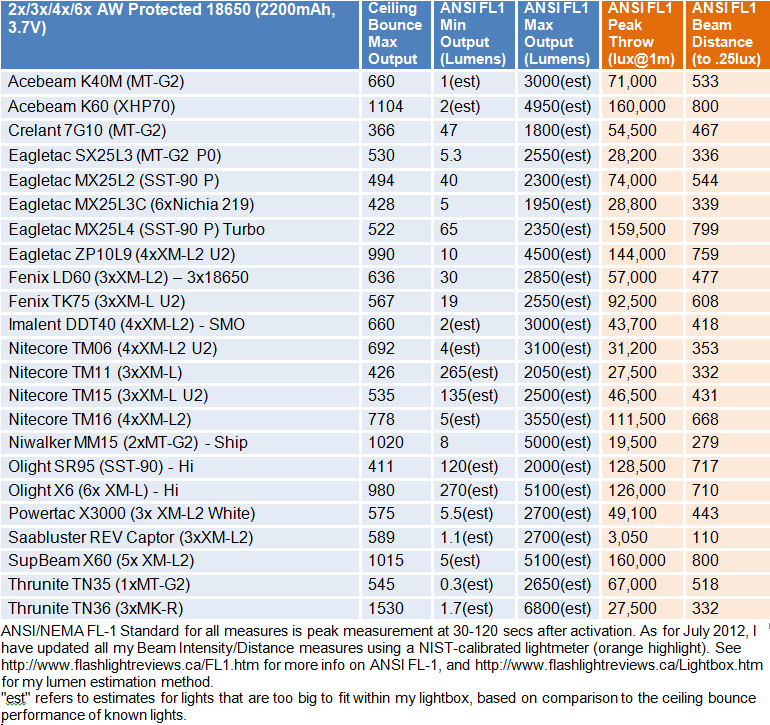
The TM16 is the highest output TM-series light yet, exceeding most other 4xXM-L2 lights or MT-G2 lights (although the higher-power Eagletac ZP10L9 is still a champ here). Throw is very good for this style of light.
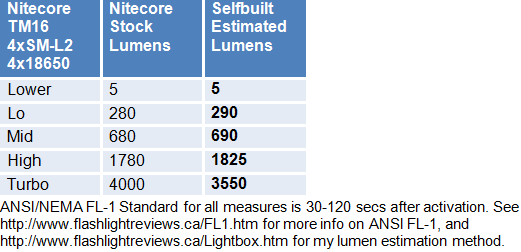
Stated output specs seem reasonable, based on my testing.
Output/Runtime Comparison:
I currently do all my runtime testing on Panasonic NCR18650A (3100mAh) based protected ICR cells.
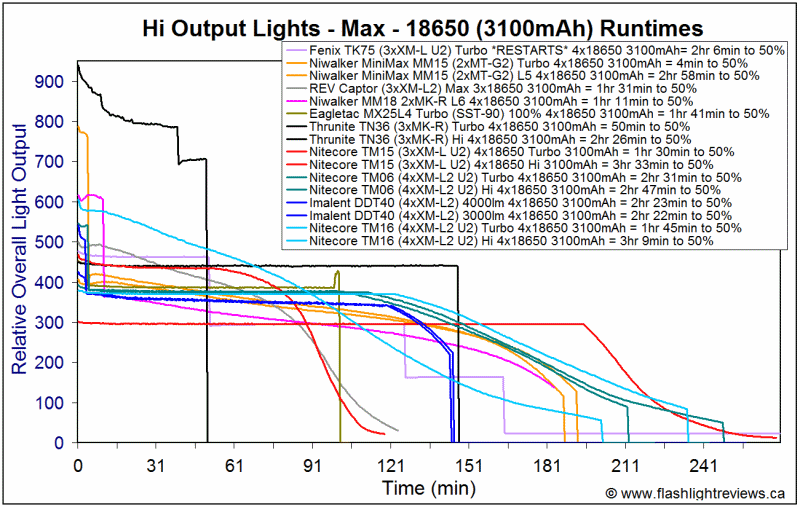
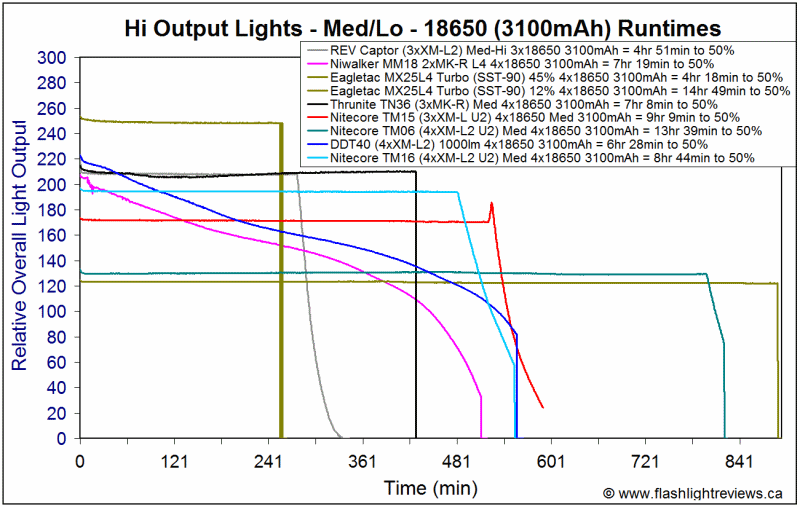
Max output is definitely higher on the TM16 than the earlier TM-series lights – although overall efficiency seems pretty much identical to the recent TM06 at the lower levels, as you would expect.
Potential Issues
Due to the electronic switches in the head, the light has a stand-by current when batteries are installed. I have not measured it in this case, but on most Nitecore lights it tends to be in a range that will drain fully-charged batteries over a course of months.
You can physically lock out the light, but this requires un-screwing the tailcap more than half-way off. I recommend you use the electronic lock-out in regular use, to prevent accidental activations.
Due to the large overlapping reflector wells, there are significant spillbeam artifacts on the periphery of the beam.
The light is larger than the earlier Tiny Monsters, and doesn't come with a holster.
Tripod mount is a nice touch, but seems unusually placed on the tail.
Preliminary Observations
This latest member of the popular "Tiny Monster" series from Nitecore is definitely more on the Monster side of the equation.
The physical interface has been updated (although not its functionality). Instead of the common two-stage button on the earlier TM-series lights, you now get two distinct buttons (as on the multi-cell EA-series lights). Otherwise, the actual feature set is not that different. Personally, I prefer the dual button arrangement here, as it doesn't rely on you getting the pressure settings just right.
Overall output/runtime efficiency remains very good as before - consistent with a good current-controlled circuit.
But what is really distinctive is the beam pattern – you get a lot of throw on the TM16. Due to the overlapping reflector wells, you also get significant beam artifacts in the periphery. Beam pattern is consistent with other high-output, multi-emitter throwers in this class and size.
It's a small matter, but I do wish Nitecore had provided some sort of holster for the light. Given the dimensions, this can be a tricky thing to carry (i.e., just like the Fenix TK75).
The TM16 is a solid offering in the high-output, multi-emitter, "throwy" class of lights. You get a very good range of features and controls. I can certainly see this model doing well for the multi-emitter class, although I'm personally becoming more interested in the new high-output emitters (e.g. Cree XHP70-based lights). But the TM16 is an interesting choice when compared to the earlier TM-series lights.
----
TM16 provided by Nitecore for review.
Last edited:


